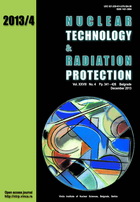
A NEW MATHEMATICAL MODEL FOR DETERMINING FULL-ENERGY PEAK EFFICIENCY OF AN ARRAY OF TWO GAMMA DETECTORS COUNTING RECTANGULAR PARALLELEPIPED SOURCES

Vol.
XXVIII, No. 4, Pp. 341-426
December 2013
UDC 621.039+614.876:504.06
ISSN 1451-3994
Pages: 370-380
Authors: Mohamed S. Badawi, Mohamed E. Krar, Ahmed M. El-Khatib,
Slobodan I. Jovanović, Aleksandar D. Dlabač, Nikola N. Mihaljević
Abstract
This work deals with full-energy peak efficiency for a counting array of two NaI(Tl) scintillation detectors (2" x 2" and 3" x 3" with 7.5% and 8.5% resolutions, respectively) and radioactive sources in the form of rectangular parallelepipeds of various dimensions. Aqueous solutions containing the 152Eu radionuclide were used; the latter exhibits a favourable multiline gamma spectrum covering a wide energy range from121.78 keV up to 1408.03 keV. A new mathematical and analytical approach to the problem is developed. The well known, accurate and widely used efficiency transfer principle is applied, together with detector efficiency calculations based on the effective solid angle concept. The self-attenuation of the source matrix, attenuation by the source container and detector housing materials, as well as a number of other relevant details of the experimental set-up were duly accounted for. A remarkable agreement between the measured and calculated efficiencies was observed for a variety of source-to-detectors distances, confirming the reliability of the method developed.
Key words: effective solid angle, full-energy peak efficiency, gamma detector, rectangular
parallelepiped source
FULL PAPER IN PDF FORMAT (2,6 MB)